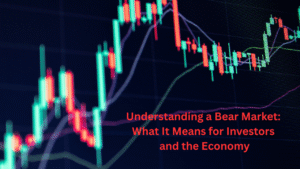 Understanding a Bear Market: What It Means for Investors and the Economy
Understanding a Bear Market: What It Means for Investors and the Economy
In the world of finance and investing, few terms strike as much concern—or intrigue—as “bear market.” For seasoned investors and casual traders alike, bear markets represent a period of caution, volatility, and often, opportunity. But what exactly is a bear market, how does it occur, and what should investors do when one strikes? This article explores the concept in depth.
What Is a Bear Market?
A bear market is typically defined as a period when stock prices fall by 20% or more from recent highs and remain at depressed levels for an extended period. This downturn can affect a specific index like the S&P 500, an entire sector (such as technology or real estate), or the stock market as a whole.
The name “bear market” comes from the way a bear attacks its prey—swiping downward with its paws. This contrasts with a bull market, in which prices rise, named after the way a bull thrusts its horns upward.
Bear markets reflect widespread pessimism and negative investor sentiment. While they are a natural part of the economic and market cycle, they can have significant impacts on investor portfolios, consumer confidence, and the broader economy.
Causes of a Bear Market
Bear markets can be triggered by a variety of economic, political, or global events. Here are some common causes:
- Economic Recession: When the economy slows, companies earn less, leading to lower stock valuations.
- High Inflation or Deflation: Sudden spikes in inflation can erode purchasing power, while deflation can signal weakening demand.
- Rising Interest Rates: As central banks increase interest rates to combat inflation, borrowing becomes more expensive, which can slow economic growth.
- Geopolitical Tensions: Wars, political instability, or pandemics can create uncertainty and prompt a market sell-off.
- Financial Crises: Banking collapses, debt defaults, or housing market crashes can act as catalysts for market decline.
These triggers often cause a domino effect, leading to a loss of investor confidence, decreased corporate spending, and lower earnings expectations, all contributing to falling stock prices.
Historical Examples of Bear Markets
Several major bear markets have shaped the financial landscape over the past century:
- The Great Depression (1929–1932): One of the most devastating bear markets in U.S. history, with the Dow Jones Industrial Average (DJIA) losing nearly 90% of its value.
- Dot-com Crash (2000–2002): The collapse of internet-based companies led to a steep market decline, especially in the NASDAQ.
- Global Financial Crisis (2007–2009): Triggered by the subprime mortgage crisis, the S&P 500 fell over 50% from its peak.
- COVID-19 Crash (February–March 2020): The pandemic led to a sharp but short-lived bear market, with the S&P 500 dropping 34% in a matter of weeks before rebounding quickly.
Each of these bear markets had different causes, durations, and recoveries, highlighting the complexity and unpredictability of market downturns.
Phases of a Bear Market
A bear market often unfolds in stages:
- Initial Decline: Triggered by a negative event or shift in economic conditions. Investors begin selling off stocks.
- Panic Selling: As more investors sell, panic sets in, accelerating the decline. News becomes more negative, and fear takes over.
- Capitulation: Investors give up hope of recovery and sell at a loss. This is often when the market hits its lowest point.
- Bottoming Out: Prices stabilize and trading volume decreases. Confidence starts to slowly return.
- Recovery: The economy begins improving, and the market starts to rebound. Optimism and buying activity return.
Understanding these stages can help investors navigate the turbulence with a clearer head and a better strategy.
Effects of a Bear Market
Bear markets can have wide-ranging effects:
- Investor Portfolios: Sharp declines in equity markets can reduce the value of retirement accounts and personal investments.
- Consumer Spending: As people see their wealth shrink, they may spend less, slowing economic growth further.
- Corporate Performance: Lower consumer demand can lead to layoffs, budget cuts, and bankruptcies.
- Government Policy: Bear markets often prompt central banks and governments to introduce stimulus measures to revive the economy.
Despite the fear and uncertainty, bear markets are often followed by periods of strong growth, making them both a risk and an opportunity for long-term investors.
How Long Do Bear Markets Last?
Historically, bear markets tend to be shorter than bull markets. According to data from Ned Davis Research:
- The average bear market since World War II has lasted about 14 months.
- The average decline during a bear market is around 33%.
- In contrast, bull markets typically last about 5 years and see average gains of over 150%.
Although painful in the short term, bear markets are a normal and necessary part of the market cycle. They often reset overvalued assets and pave the way for sustainable growth.
How to Invest During a Bear Market
While bear markets can be nerve-wracking, they also offer opportunities. Here are some strategies investors might consider:
- Stick to a Long-Term Plan: If your investment horizon is long, resist the urge to sell during dips. Time in the market often beats timing the market.
- Dollar-Cost Averaging: Invest fixed amounts regularly. This strategy buys more shares when prices are low and fewer when they’re high.
- Diversify: Spread your investments across sectors, asset classes, and geographies to reduce risk.
- Consider Defensive Stocks: Utilities, consumer staples, and healthcare tend to be more stable during downturns.
- Hold Cash: Having liquidity gives you the ability to take advantage of buying opportunities.
- Avoid Panic Selling: Emotional decisions can lock in losses. Bear markets often end when pessimism peaks.
Remember, some of the best buying opportunities in history have occurred during bear markets.
Conclusion
Bear markets are a challenging but essential part of the investment landscape. They test investor discipline, expose weaknesses in portfolios, and often serve as turning points in the economic cycle. While the pain of falling prices and economic uncertainty is real, bear markets also offer the chance to reassess, rebalance, and prepare for the next phase of growth.
For those who stay informed, patient, and focused on long-term goals, bear markets can ultimately be less of a threat—and more of a steppingstone toward future financial success.
